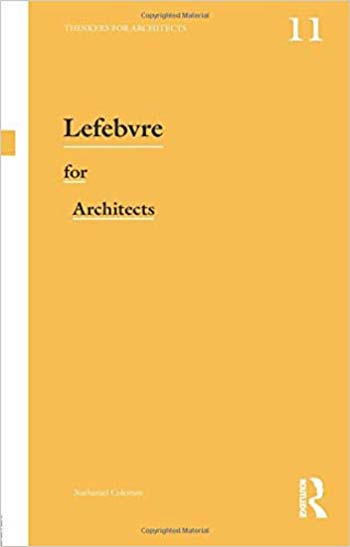نام کتاب: Lefebvre for Architects
نویسنده: Nathaniel Coleman
ویرایش: ۱
سال انتشار: ۲۰۱۴
فرمت: PDF
تعداد صفحه: ۱۷۲
انتشارات: Routledge
Description About Book Lefebvre for Architects From Amazon
While the work of Henri Lefebvre has become better known in the English-speaking world since the 1991 translation of his 1974 masterpiece, The Production of Space, his influence on the actual production of architecture and the city has been less pronounced. Although now widely read in schools of architecture, planning and urban design, Lefebvre’s message for practice remains elusive; inevitably so because the entry of his work into the Anglosphere has come with repression of the two most challenging aspects of his thinking: romanticism and Utopia, which simultaneously confront modernity while being progressive.
Contemporary discomfort with romanticism and Utopia arguably obstructs the shift of Lefebvre’s thinking from being objects of theoretical interest into positions of actually influencing practices. Attempting to understand and act upon architecture and the city with Lefebvre but without Utopia and romanticism risks muting the impact of his ideas. Although Utopia may seem to have no place in the present, Lefebvre reveals this as little more than a self-serving affirmation that ‘there is no alternative’ to social and political detachment. Demanding the impossible may end in failure but as Lefebvre shows us, doing so is the first step towards other possibilities. To think with Lefebvre is to think about Utopia, doing so makes contact with what is most enduring about his project for the city and its inhabitants, and with what is most radical about it as well.
Lefebvre for Architects offers a concise account of the relevance of Henri Lefebvre’s writing for the theory and practice of architecture, planning and urban design. This book is accessible for students and practitioners who wish to fully engage with the design possibilities offered by Lefebvre’s philosophy.
درباره کتاب Lefebvre for Architects – ترجمه شده از گوگل
در حالی که اثر هنری لوفور در جهان انگلیسی زبان شناخته شده تر از زمان ترجمه ۱۹۹۱ شاهکار خود در سال ۱۹۷۴، «تولید فضا»، نفوذ او در تولید واقعی معماری و شهر کمتر شده است. اگر چه در حال حاضر به طور گسترده ای در مدارس معماری، برنامه ریزی و طراحی شهری خوانده می شود، پیام لوفور برای تمرین هنوز بی اهمیت است؛ ناگزیر به این علت است که ورود کار او به محیط زیست، با سرکوب دو جنبه ای که بیشترین چالش در تفکر او را به دنبال دارد، است: رمانتیک و اوتوپی که همزمان با مدرنیته مقابله می کند.
ناراحتی معاصر با رمانتیک و اوتوپی، مسلما مانع از تفکر لوفور از ابعاد تفکر نظری به موقعیتی است که در واقع بر شیوه های تاثیر گذار تاثیر می گذارد. تلاش برای درک و عمل معماری و شهر با لوفور، اما بدون اوتوپی و رمانتیسیسم، باعث می شود تا تأثیر اندیشه های او را خفه کند. اگرچه لوتو به نظر میرسد که در حال حاضر هیچ جایگاهی ندارد، لوفور این را کمی بیشتر از تصدیق خودخواهانه نشان میدهد که «هیچ جایگزینی برای جدایی اجتماعی و سیاسی وجود ندارد». تقاضای غیرممکنی ممکن است به شکست منجر شود، اما همانطور که لوفور به ما نشان می دهد، انجام این کار اولین گام به سمت دیگر امکانات است. برای فکر کردن به لوفور، این است که در مورد اتوپیا فکر کنید، انجام این کار باعث می شود که با پروژه هایی که برای شهر و ساکنان آن بیشتر تحمل می کنید ارتباط برقرار کنید و با آن چه رادیکال تر از آن است.
Lefebre برای معماران ارائه می دهد یک گزارش مختصر از ارتباط نوشته هنری لوفور برای نظریه و عمل معماری، برنامه ریزی و طراحی شهری. این کتاب برای دانشجویان و تمرینکنندگان که مایل به کامل شدن امکانات طراحی شده توسط فلسفه لوفور هستند، در دسترس است.
[box type=”info”]![]() جهت دسترسی به توضیحات این کتاب در Amazon اینجا کلیک کنید.
جهت دسترسی به توضیحات این کتاب در Amazon اینجا کلیک کنید.![]() در صورت خراب بودن لینک کتاب، در قسمت نظرات همین مطلب گزارش دهید.
در صورت خراب بودن لینک کتاب، در قسمت نظرات همین مطلب گزارش دهید.
[tabs slidertype=”simple” auto=”yes”] [tab]
دسته های پرطرفدار دانلود کتاب معماری
- دانلود کتاب معماری پایدار
- دانلود کتاب معماری منظر
- دانلود کتاب معماری داخلی
- دانلود کتاب تاریخ معماری
- دانلود کتاب جزئیات در معماری
- دانلود کتاب آثار معماران بزرگ
- دانلود کتاب سازه در معماری
- دانلود کتاب طراحی شهری
- دانلود کتاب معماری دیجیتال
- دانلود کتاب روانشناسی محیطی
- دانلود کتاب راندو و اسکیس
[/tab] [/tabs]


فایل یافت نشد